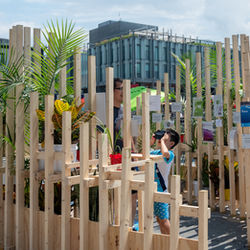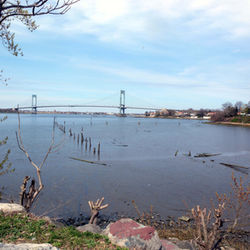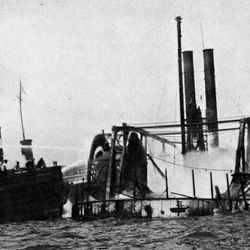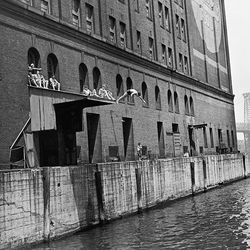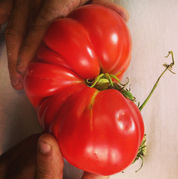River Lab pavilion at South Street Seaport in Lower Manhattan, 2022
A journey through a brief history of the East River through a ViewMaster.
The ViewMaster captures fascinating historical images of people interacting with the East River. Among the many captivating stories is that of Barney Sweeney, the expert diver who was commissioned to retrieve objects ranging from barges to human remains from the river. Sweeney was interviewed extensively by the print and radio media, yet no one has made a movie about his daring and heroic life. The ViewMaster contains a selection of slides that offer glimpses into the rich history of the East River and the remarkable people who made it what it is today.
The River Project is an ongoing exhibit at the South Street Seaport Museum in New York City. River Lab, part of The River Project, is an interactive exhibit that explores the ecology and biodiversity of the Hudson River Estuary. Visitors can participate in hands-on activities such as water quality testing and microscope observations of river specimens. The exhibit also features multimedia presentations on the history of the river and its importance to New York City. The River Project serves as a platform for community engagement, education, and advocacy for the health and preservation of the Hudson River Estuary.
Moon & Stars Farm, Miami 2014-2018
Moon and Stars Farm was a non-profit farm focused on regenerative cultural practices in agriculture, water, energy, ecology, education, art, and community. The farm's mission was to engage residents, farmers, agricultural laborers, children, artists, scientists, specialists, and ecologists in expanding the international dialogue about innovative solutions to face climate change. The farm offered an array of programming and spaces for experiential learning, including organic gardens, medicinal and herbal gardens, vegetable gardens, flower gardens, butterfly gardens, native habitats, a CSA, an outdoor kitchen, a chicken habitat, tropical fruit trees, eco-human habitats, bio-topped pond, and a plant nursery. The farm aimed to provide access to clean, healthy food and be a cultural hub where contemporary artists bring to life ecological projects in various mediums while building resiliency around food and ecology.
Colony1, Miami, 2011-2015
Colony1 was a proposed sustainable building and education center located in Miami, considered the most climate-vulnerable city in the US. The building was designed as a "living building," producing its own energy, water, and food. It featured a range of eco-friendly amenities such as solar panels, rooftop and vertical gardens, a passive cooling system, a rainwater harvesting and filtration system, and a constructed wetland system for greywater filtration.
The programming of Colony1 had unique characteristics that distinguish it from other sustainable buildings. It includes a not-for-profit Community Supported Agriculture (CSA) program, a zero-packaging bulk food store, an art and science residency program, an exhibition hall, workshops, and research facilities. The CSA program provided an annual Resilient Ambassador Training opportunity for 15 Miami residents to learn how to grow food, harvest weekly shares, and create gardens, feeding their families while creating wealth in their communities.
Midtown 34th Street Project, Miami 2012-2013
The Midtown 34th Street project was a community initiative aimed at raising awareness and educating Miami residents about sustainability and environmental practices. The project involved the transformation of a dedicated site in Miami's Midtown area into a sustainable community garden, complete with organic food production, rainwater collection, solar energy, and mobile eco live/work units. It also featured community composting, vermiculture, and open demonstrations of gardening, yoga, and educational activities for children.
As a precursor to a larger development called Colony1, Midtown 34th Street was a platform for fostering support and resources for the ambitious sustainable arts center. The larger initiative would have consisted of a natively landscaped green space, an international arts and sciences residency program, an education center, a bulk/0 packaging food store, community mulch, aquaculture ponds, and much more. The aim was to create an epicenter for innovation and engagement in Miami while also serving as a platform for sustainable initiatives and a public interface for locally oriented, internationally focused projects.
